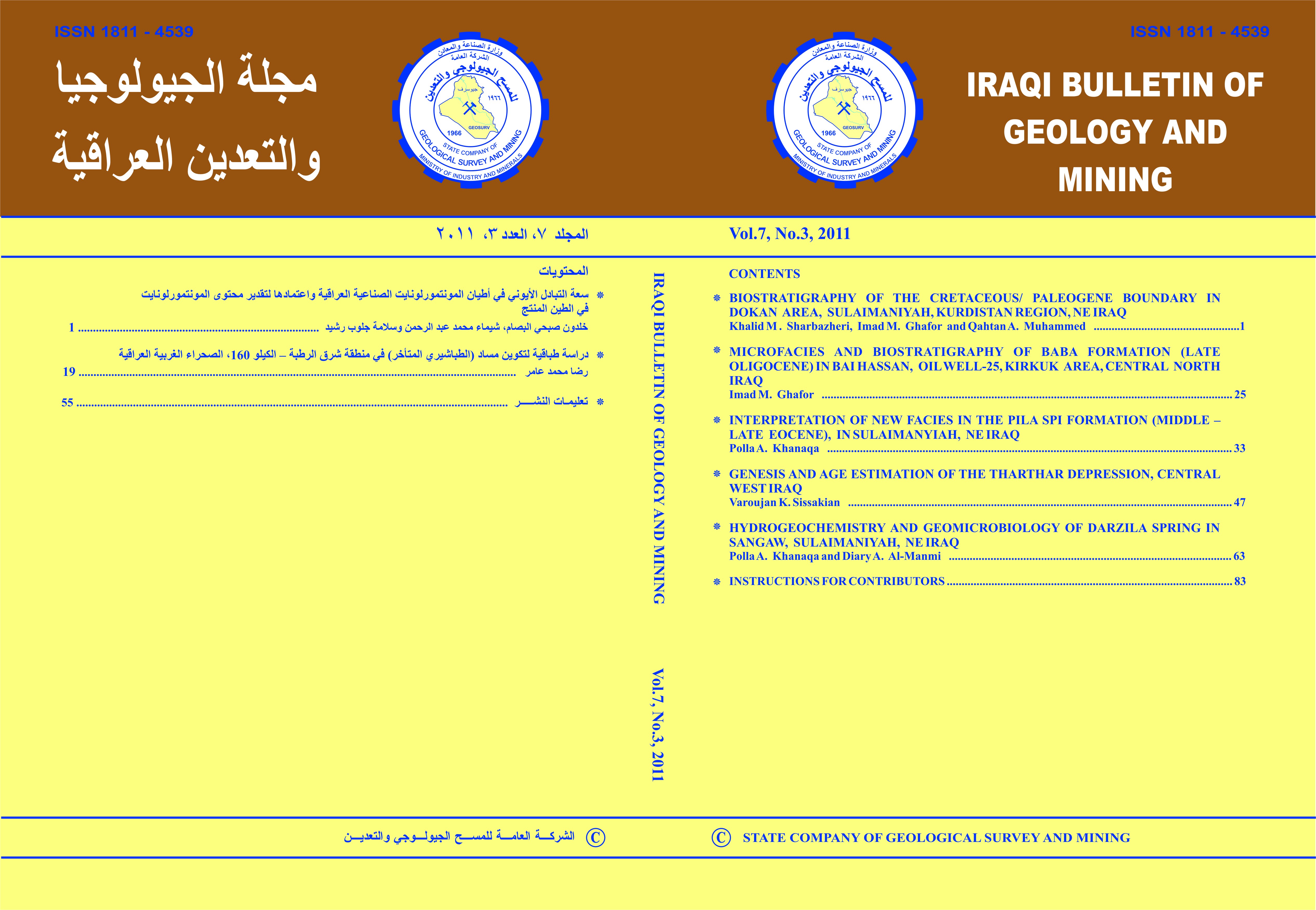Abstract
The studied area is located within the High Folded Zone in Dokan area, northeastern Iraq. The Cretaceous/ Paleogene boundary consists of flysch clastic beds of Tanjero and Kolosh formations, interbedded with marl. The study is achieved on the outcrops of the uppermost part of the Late Cretaceous successions (upper part of Tanjero Formation) and the Early Paleogene (lowermost part of Kolosh Formation). Based on identified planktonic foraminiferal assemblages, five biozones were recorded from the upper part of the Tanjero Formation, these zones are from bottom to top: Pseudotextularia intermedia Interval Zone (CF5), Racemiguembelina fructicosa Interval Zone (CF4), Pseudoguembelina hariaensis Interval Zone (CF3), Pseudoguembelina palpebra Interval Zone (CF2), Plummerita hantkeninoides Total Range Zone (CF1) and two biozones were recorded from the lower part of Kolosh Formation, which are: (P1a) Parvularugoglobigerina eugubina – Subbotina triloculinoides Interval Zone and (P1b) Subbotina triloculinoides – Globanomalina compressa/ Praemurica inconstans Interval Zone.
The result of the present study (in contrast to previous studies) shows that the Early Danian is found for the first time in the sediments of the Kolosh Formation. It is possible that the other two zones: P0 (Guembelitria cretacea Zone), and Pα (Parvularugoglobigerina eugubina Zone) were not recorded completely or continuously in the studied area. The biostratigraphic correlations; based on planktonic foraminiferal zonations showed a comparison between the biostratigraphic zones, which were established in this study with other equivalents of the commonly used planktonic zonal scheme around the Cretaceous/ Paleogene boundary, in and outside Iraq.
The result of the present study (in contrast to previous studies) shows that the Early Danian is found for the first time in the sediments of the Kolosh Formation. It is possible that the other two zones: P0 (Guembelitria cretacea Zone), and Pα (Parvularugoglobigerina eugubina Zone) were not recorded completely or continuously in the studied area. The biostratigraphic correlations; based on planktonic foraminiferal zonations showed a comparison between the biostratigraphic zones, which were established in this study with other equivalents of the commonly used planktonic zonal scheme around the Cretaceous/ Paleogene boundary, in and outside Iraq.
Keywords
Biostratigraphy
Cretaceous/ Paleogene boundary
Iraq
Kurdistan region
Sulaimaniyah
Abstract
إن وحدات التماس بين عصری الطباشيری الأعلى والپاليوجين الأسفل المتكشفة في منطقة الدراسة التي تقع في نطاق الطيات العالية، وتمتد باتجاه شمال غرب - جنوب شرق على شكل شريط ضيق قريب وموازی للحدود العراقية – الإيرانية، تتكون من طبقات سميكة تتألف بشكل رئيسي من تتابعات الفليش ممثلةً بالصخور الفتاتية لتكويني تانجيرو وكولوش. سجلت في هذه الدراسة خمسة أنطقة حياتية لتجمعات الفورامينيفيرا الطافية ضمن الجزء العلوي من تكوين تانجيرو, وكذالك تم تمييز نطاقين حياتيين ضمن الجزء السفلى لتكوين كولوش (الپاليوسين الأسفل) في منطقة الدراسة.
عکست الأنطقة الحياتية للفورامينفيرا الطافية الموصوفة فی منطقة الدراسة استمرار الترسيب عبر حد التماس بين الطباشيری والپالوجين وعدم وجود دلائل على الانقطاع، بالإضافة إلي ذلك تم تسجيل الدانيان (Danian) لأول مرة في المنطقة، ودلت علی وجود ترسيب تدريجی مستمر فی منطقة الدراسة. أجريت مضاهاة بين الأنطقة الحياتية التی سجلت فی هذه الدراسة اعتماداً على الفورامينفيرا مع الأنطقة المکافئة لها ذات الاستعمال الشائع حول حدود التماس بين الطباشيری والپاليوجين فی داخل وخارج العراق.
عکست الأنطقة الحياتية للفورامينفيرا الطافية الموصوفة فی منطقة الدراسة استمرار الترسيب عبر حد التماس بين الطباشيری والپالوجين وعدم وجود دلائل على الانقطاع، بالإضافة إلي ذلك تم تسجيل الدانيان (Danian) لأول مرة في المنطقة، ودلت علی وجود ترسيب تدريجی مستمر فی منطقة الدراسة. أجريت مضاهاة بين الأنطقة الحياتية التی سجلت فی هذه الدراسة اعتماداً على الفورامينفيرا مع الأنطقة المکافئة لها ذات الاستعمال الشائع حول حدود التماس بين الطباشيری والپاليوجين فی داخل وخارج العراق.
